
KILIMANJARO
An expedition to summit Africa’s
highest peak in less than 31 hours.
By JAMES MCINTOSH & TARYNNE MINGIONE
BASE CAMP
“It’s just an easy three-day hike halfway up,” we told ourselves. “We’ll be fine.”
We hadn’t left enough time before our flight out of Tanzania to summit Mt. Kilimanjaro, so instead we opted for a three-day hike halfway up the mountain to get a good view of the tallest peak on the African continent before we left.
The day before we had researched online and found the company Zara Tours. There was no three-day trek listed on the website, so we called and asked if a three-day hike halfway up the mountain was an option. The person on the phone said yes, so we booked it and took a public bus from Nairobi, Kenya to the town of Moshi, Tanzania near the base of Mt. Kilimanjaro.
After a deep night of sleep in Moshi, we were standing in the driveway of our hotel with our trekking bag packed, ready to set out on our abridged climb to get a close up look of the famed mountain.
Since we were only camping two nights and not reaching an altitude high enough to encounter snow, we packed light. No hiking boots, rain or snow pants, hats or gloves, walking sticks, multiple pairs of socks, or extra clothes.
In fact, we were bringing so little, we decided it would be best to put all our gear in one shared pack. It weighed less than 10 kg and contained two sleeping bags, two light rain jackets, two sweatshirts, some snacks and a pack of playing cards.
Moments later a van pulled up in the hotel driveway and the guide we had met the night before jumped out.
Daniel was thin and lanky but built of solid muscle from a lifetime of trekking up and down Mt. Kilimanjaro. He was 31-years-old, had spent his entire life around the mountain and had been leading groups to the summit for almost ten years.
“Where’s your second bag?” He asked, confused.
“There’s only one,” we replied.
He picked it up and seemed to be calculating what to do with our extra porter. Each hiker on Kilimanjaro is required to have their own porter who can carry up to 15 kg.
“It’s light,” he said, looking at us cautiously.
Thanks to our light packing, our porters only had one bag between them and could take turns carrying it.
“Alright,” said Daniel. “Let’s get moving.”
We climbed into the van, which drove for about an hour and a half to the base of Mt. Kilimanjaro. At 11:00 a.m. we arrived, signed in at the Marangu Gate and began our ascent up the mountain.
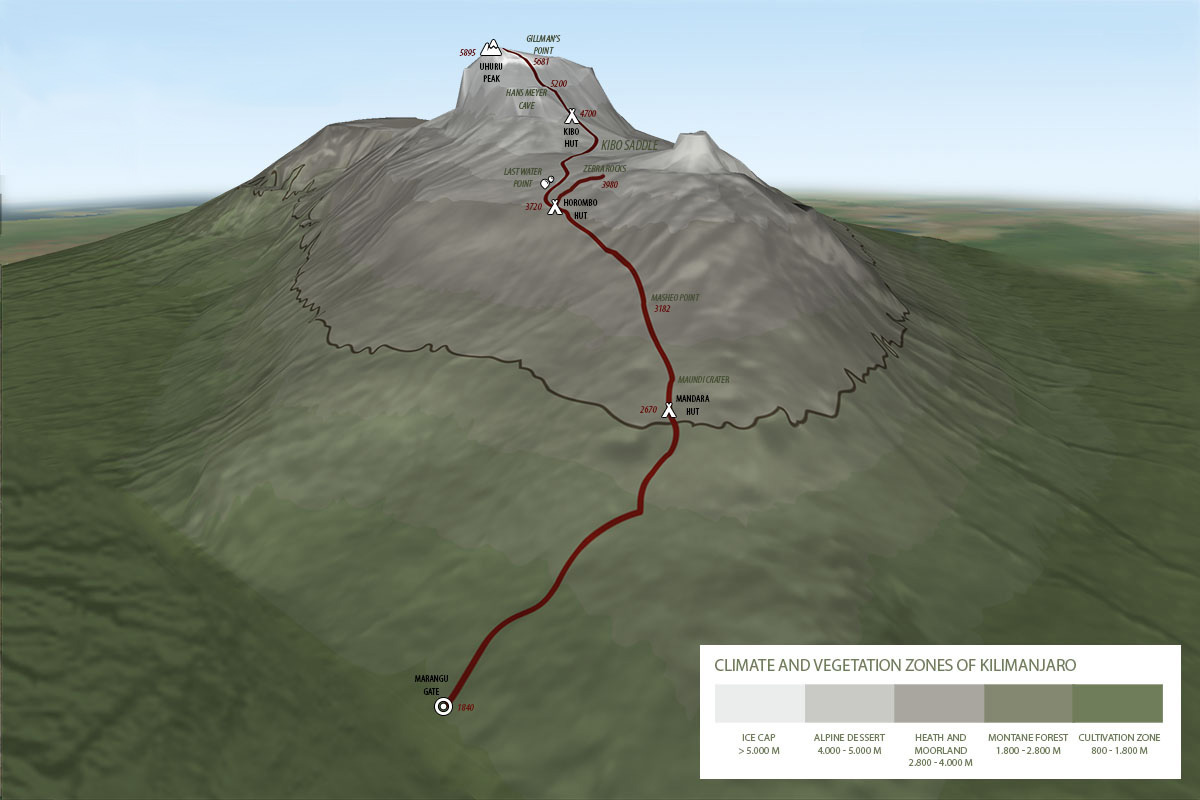 The Marangu Route to summit Mt. Kilimanjaro, Tanzania.
The Marangu Route to summit Mt. Kilimanjaro, Tanzania.
(Map courtesy of Kilimanjaro Experience)
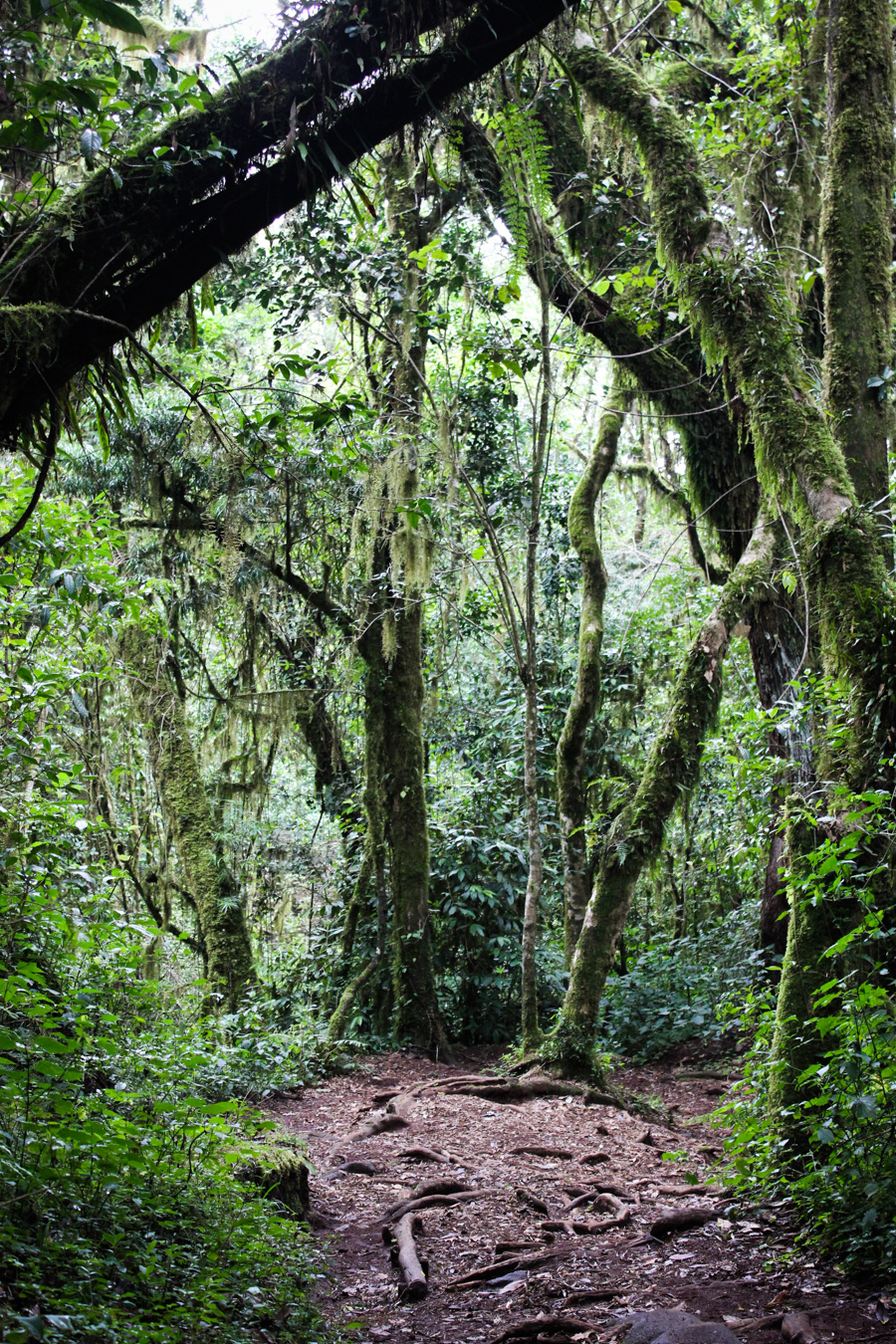
Dense Montane Forest near the Marangu Gate (1900 m).
MARANGU
Moving away from the entrance to the park we were surrounded by dense rainforest with gentle waterfalls scattered throughout the damp smelling vegetation. It felt familiar, like hiking in the Northwest where we grew up. The clean, fresh air and sense of familiarity gave us a tendency to pick up the pace and hike faster.
“Pole, pole,” Daniel kept saying. Swahili for slow, slow.
Although the plan was to only reach a final altitude of 3780 m, there was still the chance to get altitude sickness if we bulldozed up the mountain too quickly.
Acute mountain sickness can often occur above 2500 m. Since it can strike anyone, regardless of age and fitness level, Daniel’s primary job aside from not getting lost was to set the pace to ensure we got to our destination feeling well and standing upright.
Feeling buzzed from the sweet fresh air and stillness that surrounded us, we curiously asked Daniel about what it’s like to reach the summit. In nine years of leading groups up the mountain, he reported an impressive success rate for getting people to the top.
“The quickest I’ve ever done the whole thing is two nights, three days,” he said. “That pace was required to complete the guide examination.”
We quickly glanced at one another behind his back. Our minds silently entertained the idea of conquering this mountain in only three days as we carried on up the trail for another hour before stopping to eat lunch.
In the company of a pack of blue monkeys swinging in the trees overhead, we sat on a fallen log and began to unwrap our lunches. We couldn’t get the idea of trying to summit out of our heads. We were fully aware the risk of AMS was high going from 2000 m to 5790 m in just 24 hours, but the fact we now knew it was possible was just too alluring.
Daniel called an end to lunch and we made our way back to the trail, continuing along the Marangu Route. About 20 minutes passed by before we had to ask.
“Is there any way, I mean is it physically possible, if we, eh, try to summit tomorrow?”
“Ha, you really want to go all the way up, tomorrow?”
We sheepishly smiled back, still walking and trying to look as in shape and confident as possible.
“Yeah, we can try,” he said with a wry smile.
Excited, we picked up the pace.
ORIGINAL ITINERARY
DAY 1:
Start at Marangu Gate, elevation 1850 m. Gain 850 m elevation to Marangu Huts, final elevation 2720 m. Total hike time three to four hours.
DAY 2:
Starting elevation 2720 m at Marangu Huts. Hike six to eight hours to Horombo Huts, elevation 3700 m.
DAY 3:
Descend from Horombo Huts to Marangu Gate. Total hike time six hours.
NEW ITINERARY
DAY 1:
Start at Marangu Gate, elevation 1850 m. Bypass Marangu Huts at 2720 m and continue all the way to Horombo Huts at 3700 m. Total hike time nine hours.
DAY 2:
Starting elevation 3700 m at Horombo Huts. Begin hiking and bypass Kibo Huts at 4700 m. Continue climbing to the summit at 5895 m. Hike all the way back down to Horombo Huts at 3700 m. Total hike time 17 hours.
DAY 3:
Descend from Horombo Huts to Marangu Gate. Total hike time six hours.
After another hour trudging through the dense rainforest and we arrived at Mandara Huts. Daniel told us to eat and drink something quickly as we had a long hike ahead of us and we wouldn’t be eating dinner until late.
The break was short, as we had a lot of ground to cover and we couldn’t climb quickly due to the significant change in altitude.
We were now racing the falling sun at a snail’s pace.
The vegetation quickly changed from dense rainforest to stubby trees, and then to small shrubs that revealed incredible views of Mt. Kilimanjaro in front of us and the setting sun.
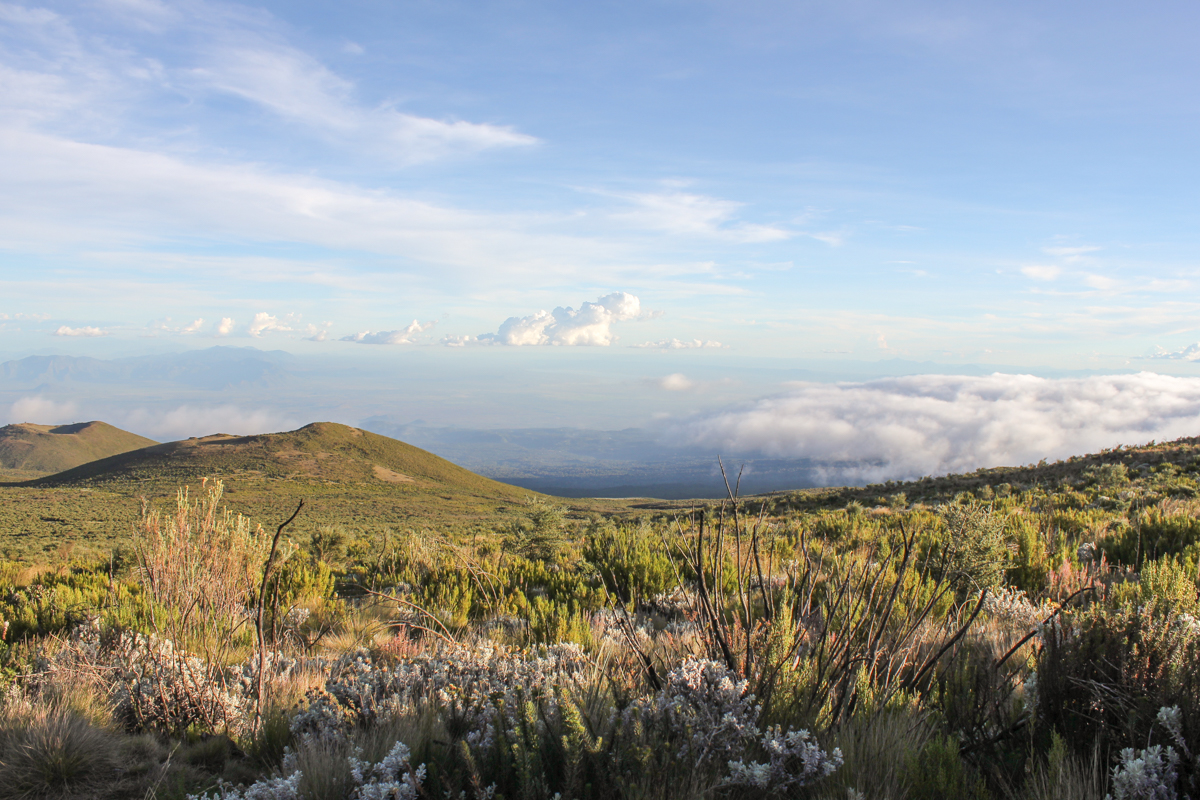

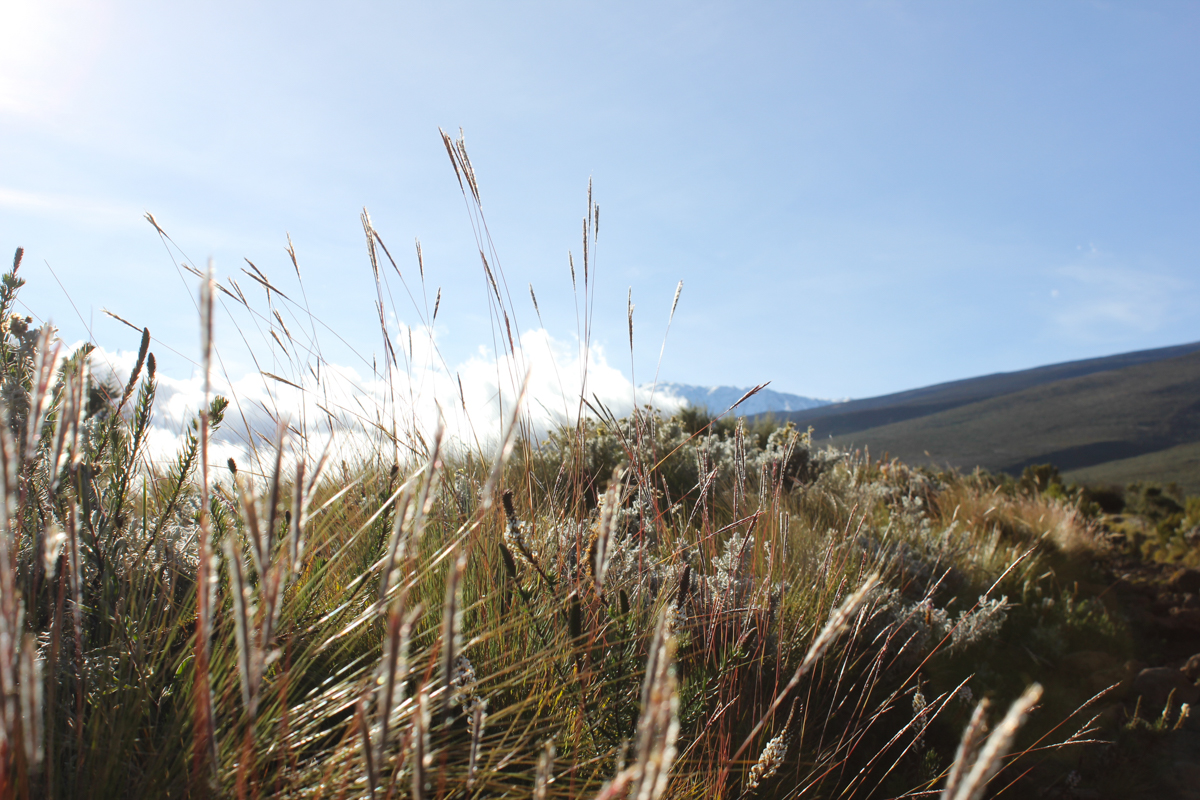
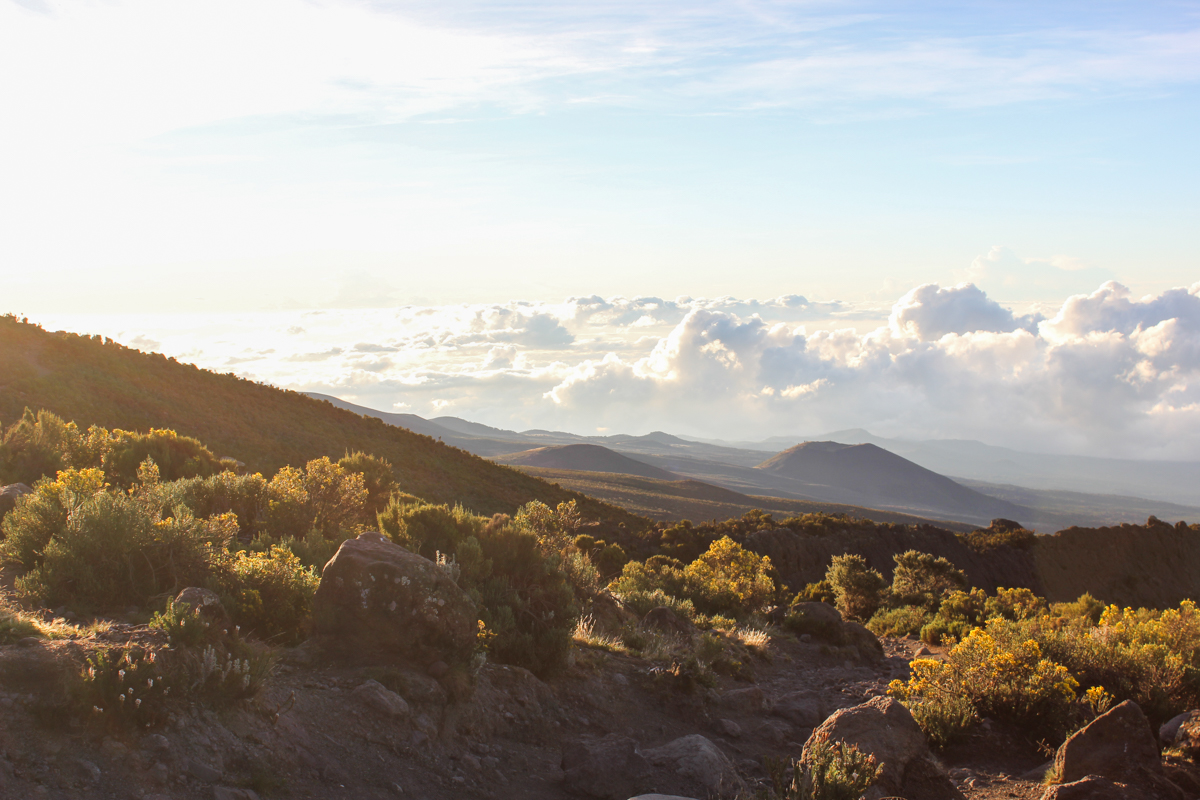

Heath and Moorland vegetation (3400 m).
By 7:30 p.m. the sun had left us, and we were alone on the quiet and deserted trail. We didn’t see a single person for the rest of the day. It was just three of us, our headlamps and the winding trail in front of us. Daniel was forcing our group to walk much slower now. It became noticeably colder. The air undeniably crisp and much less satisfying, but we pressed on into the night.
Just after 9 p.m. we arrived at Horombo Huts.
It was dark, quiet and cold. The other climbers had already disappeared into their bunks for the night and we were left on our own with only the looming silhouette of Kilimanjaro teasing us in the distance, illuminated by the full moon light.
HOROMBO
Daniel checked in with the camp caretaker, telling him we weren’t scheduled to be here tonight but needed a place to sleep as were a day ahead of our itinerary. He then led us to our hut to show off our accommodation for the night.
“You need to drink a lot of water and you need to eat dinner tonight, even though I know you aren’t hungry or thirsty,” he said. “I’ll come get you when dinner is ready.”
We stayed awake by playing cards on the floor of our hut. Feeling high from a mixture of adrenaline, excitement and a lack of oxygen, we rolled around on the floor laughing, playing speed and telling bad jokes.
At around 10:30 p.m. dinner was ready, and we made our way down to the dining hall to eat. Daniel was right. We just weren’t in the mood for eating. You would’ve thought after 10 hours of hiking we’d be shoveling food in our mouths, but we had no appetite.
We swirled our forks and slowly ate. The food wasn’t bad and eventually our plates were clean.
Daniel then sent us back to our huts to get some sleeps. We crawled into our two-layer sleeping bags and stared up into the blackness, wondering what tomorrow would hold.
What would happen tomorrow? Could we make it all the way to the summit in 31 hours?
The next day, we’d find out.
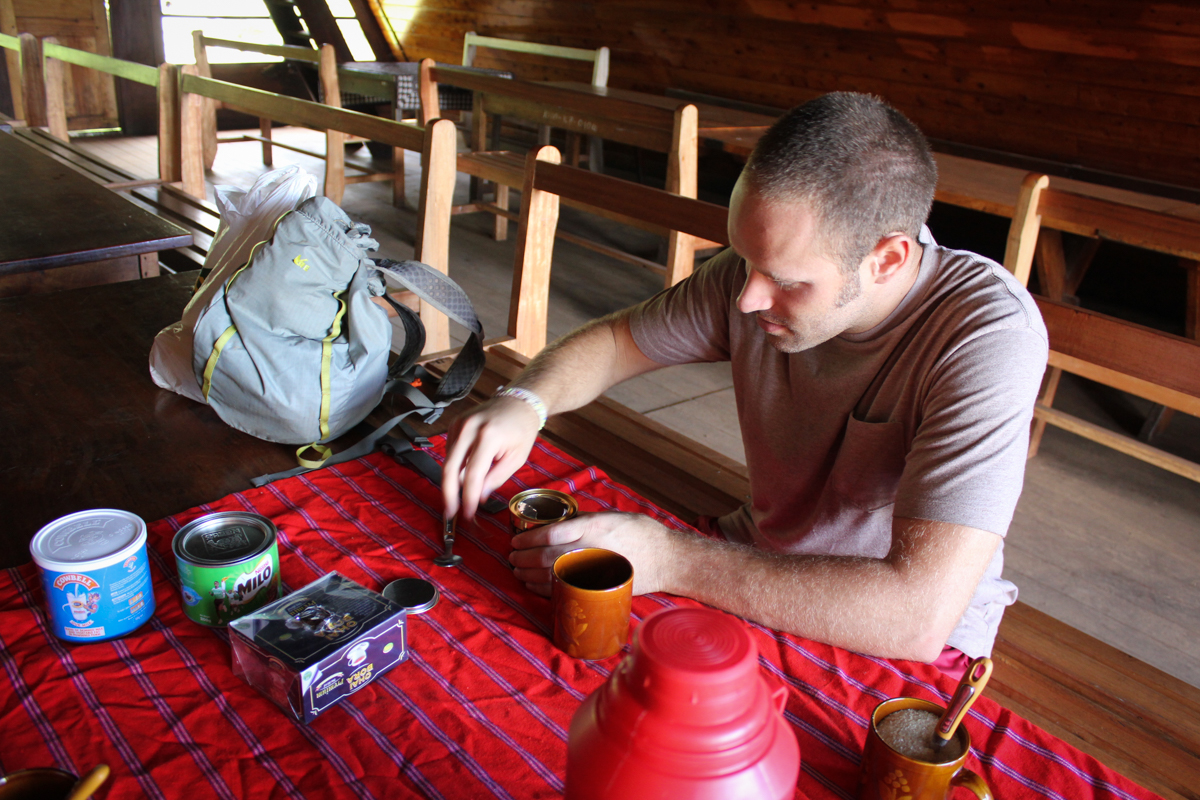
Making coffee inside a hut on Mt. Kilimanjaro.
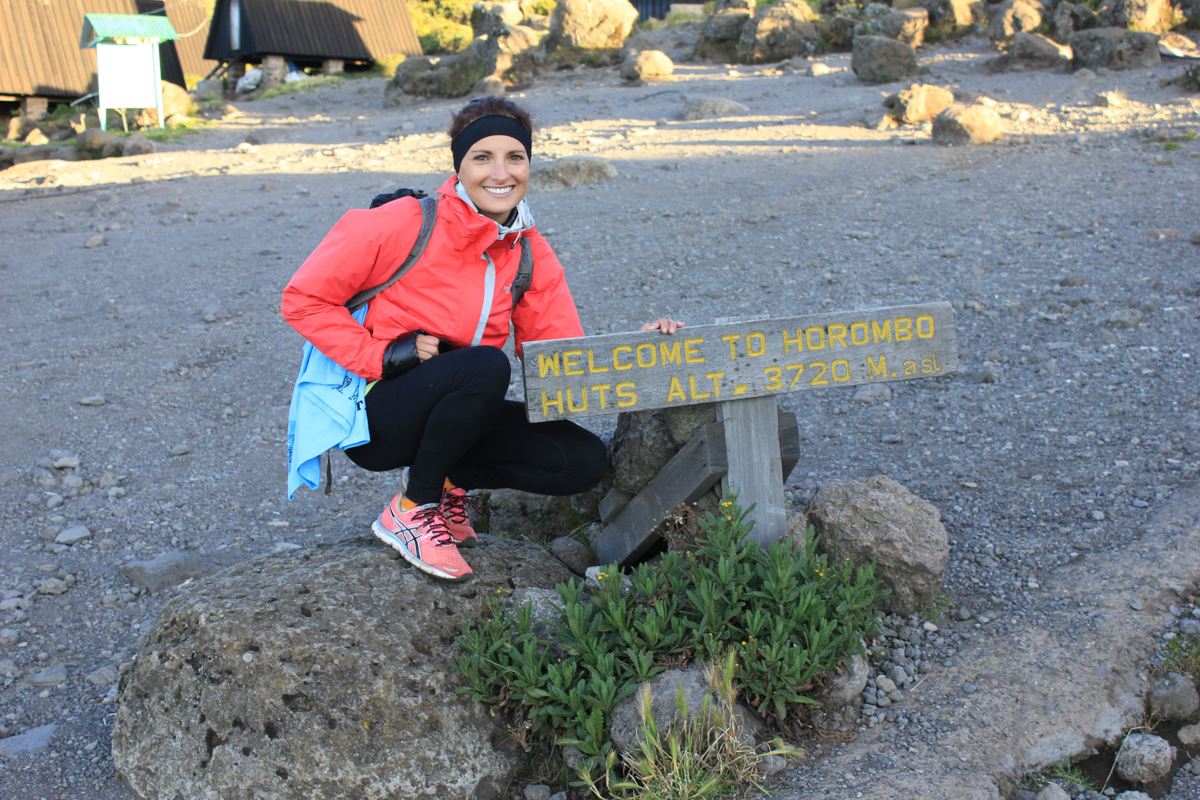
Preparing to leave Horombo Huts on summit day (3720 m).
KIBO
We were up before 7:30 a.m. anxious about the long day we had ahead of us. If everything went as planned, we’d summit sometime tonight and would return back to our hut in Horombo around midnight.
At breakfast we shared a table with several people who had summited the day before. They weren’t exactly selling it — complaining about how they felt, the horrible headaches, the freezing cold, sickness, feeling dizzy and a more challenging hike than they expected.
We drank coffee, slammed down some Diamox, ate a couple spoonfuls of peanut butter and called it good.
We pushed back from the table, “Ready?”
We were nervous as hell.
Daniel was waiting for us outside by the trailhead. As we approached him he had a solemn look on his face.
“There’s a little problem. The caretaker says you can’t summit unless you are paying for the full 5 days. He is going to call down to the gate and ensure you don’t leave until you pay.”
The three of us huddled in a circle and decided to tell the caretaker we were just seeing how far we could hike today and that we would turnaround again at Kibo Huts and sleep back at Horombo as originally planned.
Daniel told us to start up the trail while he wrapped up his conversation with the caretaker, temporarily convincing him to keep his mouth shut to see how the day unfolds before making any calls to the gate.
Kilimanjaro loomed before us as we slowly shuffled our feet down the trail. Since we were returning to Horombo to sleep we only brought day packs and our porters stayed behind with the rest of our gear.
Daniel caught up and walked in front of us, reminding us that today would be one hell of a test of our patience.
“Pole, pole,” he said.

The sun was out but it was cold and bit our faces. We hiked quietly for four hours before seeing Kibo Huts appear in the distance in front of us. It looked about a quarter of a mile, but we were walking so slow it took nearly an hour to get there. Our hearts were pounding uncomfortably fast, we were breathing heavy, but we were barely moving. It was getting noticeably colder with each step forward.
What seemed like a decade passed before we arrived at the caretaker station of Kibo Huts.
We were now at 4730 m and our bodies knew it. Even with two pairs of pants, long sleeve shirts, sweatshirts, rain jackets and socks over our hands, we were still shivering uncontrollably.
Daniel told us to eat and drink, but it was the last thing we felt like doing. We had no appetite and even water tasted gross.
“Let’s go.”
He knew we would be feeling worse very soon.
THE CRATER
The three of us started up the path from Kibo. It was expected to take five hours to reach the summit if no one got sick and we were able to ascend at a steady, slow pace. Once we reached the top it would take an hour and a half to hike along the crater’s edge to Uhuru Peak, the highest point on Kilimanjaro.
The next five hours were absolute hell.
With every step we became more and more paranoid that altitude sickness would hit, and we’d be forced to turn back after almost reaching our goal. After an hour, our heads were throbbing, we were shaking, and we felt weak and exhausted. A few more painfully slow steps forward and we began to feel loopy and drunk. It became difficult to think and remember which foot just went in front of the other.

All of a sudden, the rocks became intimidating and we couldn’t pick up our legs up over them anymore. Our walk became more of crawling scramble as we pushed on toward the peak above us. The top was so close it felt as though we could reach out and grab it.
Eventually we had to stop.
“C’mon, don’t give up now,” said Daniel. “You’ve got 45 more minutes.”
We took a quick breather to sort through it, swallow some Diamox, regain our confidence and continued upward at an even slower pace.
What seemed like the most miserably drunk and confusing 45 minutes of our lives somehow passed, and with a few final shuffles we arrived at Gilman’s Point on the edge of the crater.
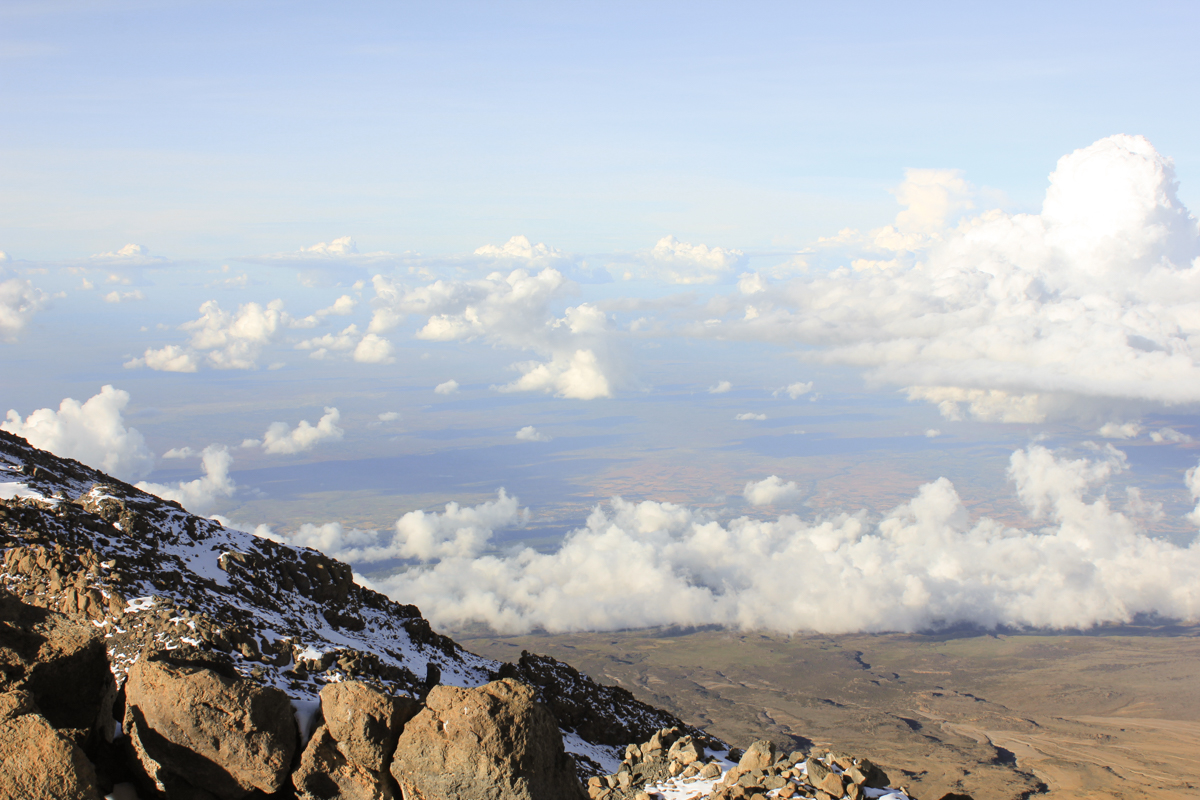

Gilman’s Point on the crater’s edge (5681 m).
THE SUMMIT
Daniel could tell we were long gone. He rummaged through his bagpack, eventually finding two juice boxes. He handed them to us.
“Drink it,” he demanded.
A few minutes later we stopped shaking and were ready to tackle the home stretch. It was an hour and a half walk around the edge of the crater to Uhuru Peak. The sun was setting quickly. We would inevitably be walking along the crater cliff in the dark and we could sense the panicked urgency coming from Daniel as he quickly led us across the snow towards the tiny signpost in the distance.
At this point we were feeling slightly better. The remaining altitude gain was minimal and that was motivation enough to keep up and follow closely in Daniels footsteps. Daniel repeatedly told us to move quickly. Neither of us really responded. We just kept focusing on putting one foot in front of the other and marching onward.
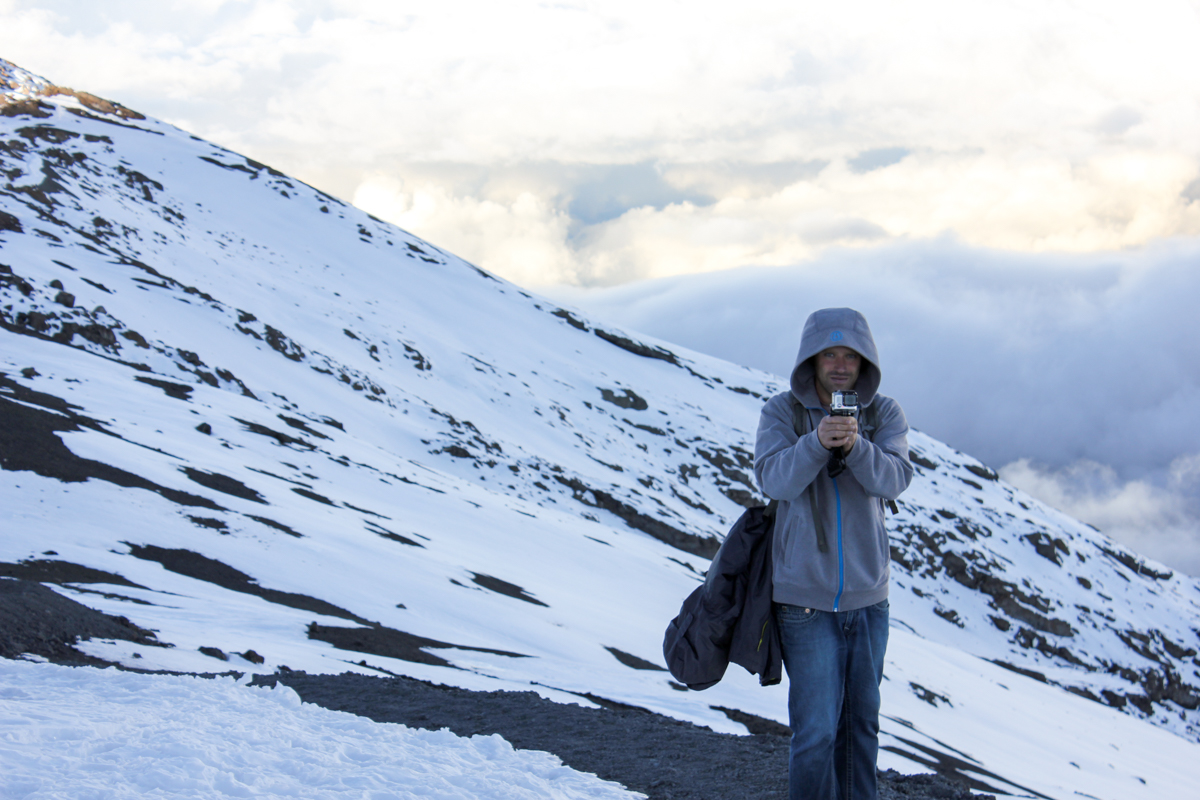
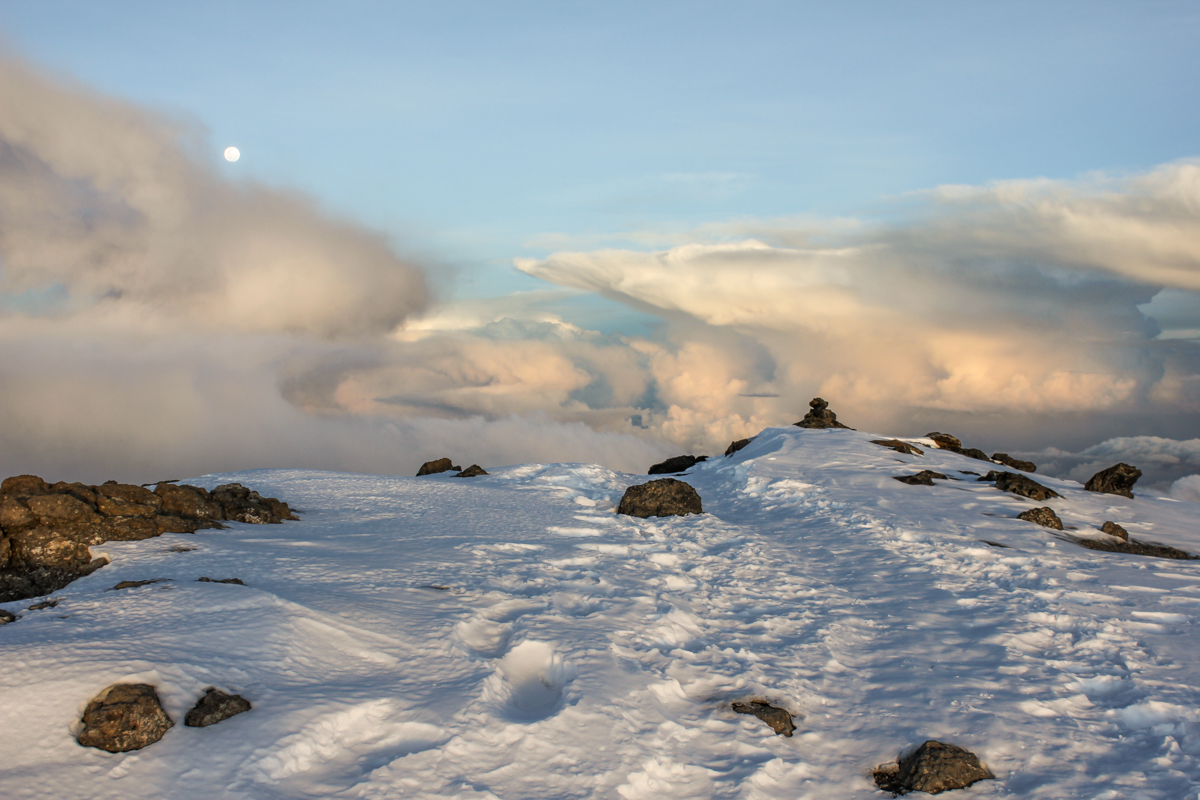
Climbing along the crater’s edge at sunset (5750 m).

The sun was setting behind the clouds beneath us. The view was absolutely incredible. We were the only three on the mountain. The snow looked like glitter, the clouds loosely clung to the sides of the glaciers around us. The African plains extended as far as the eye could see to our left and the massive volcanic crater of Mt. Kilimanjaro dropped down to our right.
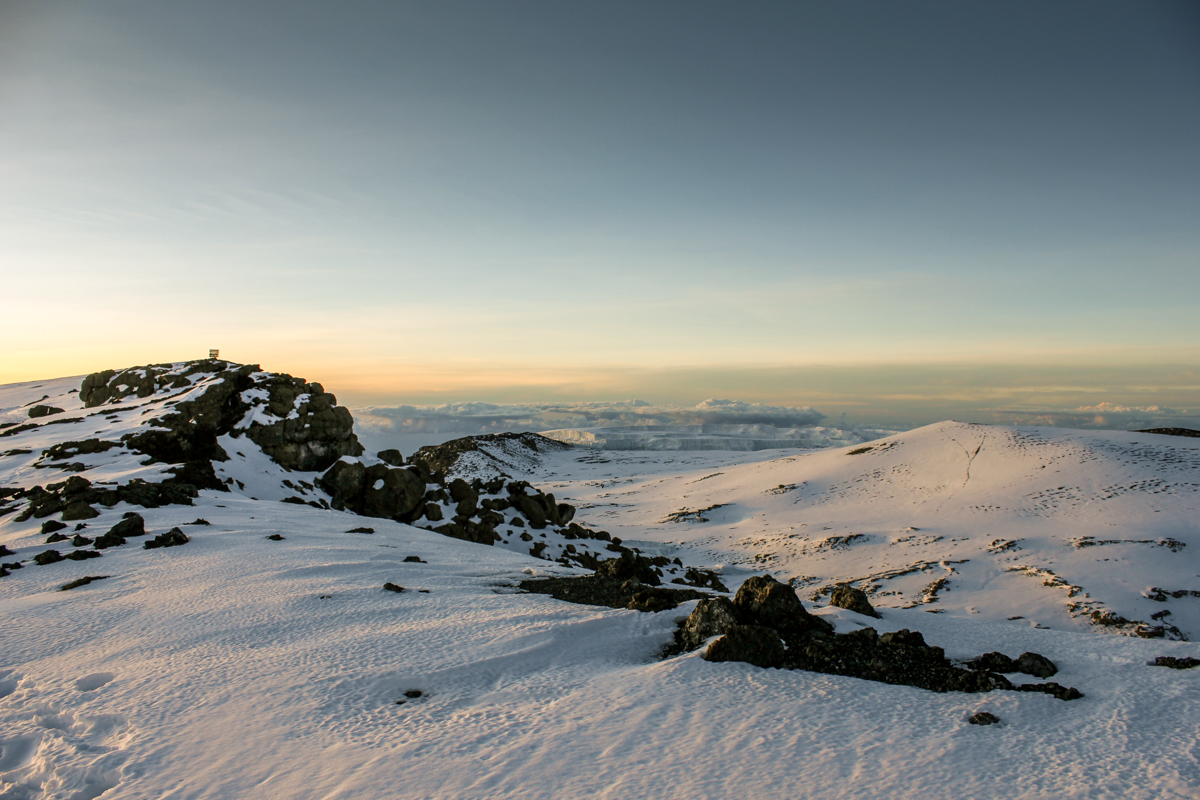
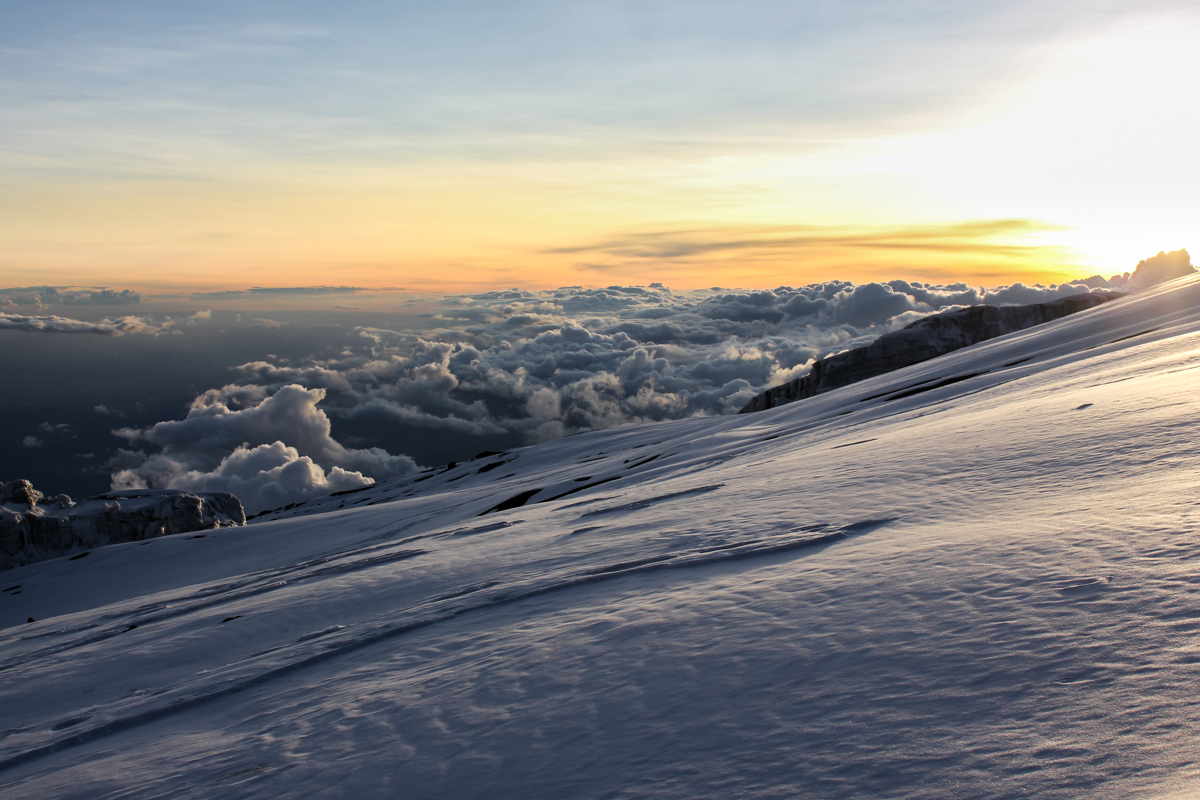
Hiking toward the summit with the sun setting in the distance (5800 m).

The last 200 meters to the signpost seemed like an eternity, but eventually we made it. Right in front of us was the signpost marking the highest point on the continent of Africa. 5895 m.
We did it. Somehow, we had summited in only 31 hours.
It was surreal. We were completely alone at the top of one of the highest mountains in the world with the sun setting around us. We hugged. We high-fived. And we took a second to take in the moment and the accomplishment of reaching the top.


The summit of Mt. Kilimanjaro (5895 m).

Then reality hit. What most people forget is reaching the summit isn’t the end of the climb. It’s only the halfway point. We still had to go all the way back down to the Horombo Huts.
In the dark.
After the brief celebration, Daniel rounded us up and led us back along the crater. We were now walking in the dark. It took 45 minutes to briskly walk back to the point where we reached the crater’s edge.
“Ok. You guys ready for this?”
Our bodies were screaming to descend.
After quickly climbing down the initial steep rocks, Daniel abandoned the zig-zagging trail we had followed on the way up and instead turned down the mountain.
We skied straight down on our heels. Daniel zoomed down effortlessly as if he was floating just above the loose rock, whereas we struggled to keep our balance and stay upright. After countless rolled ankles and summersaults, we finally arrived at Kibo huts.
We had descended in 45 minutes, a trip that was supposed to take up to three hours to return.
Outside Kibo Huts we emptied the sand and small rocks from our shoes and drank hot tea and water before Daniel reminded us we still had a heavy three-hour hike back to Horombo.
It was dark but luckily the full moon lit the trail. Our feet were bleeding, our knees were aching from the aggressive descent. Slowly the air became heavier and warmer.
What seemed like days passed. It started raining. The vegetation changed. The mountain slowly retreated into the distance behind us and we arrived back to Horombo.
“You guys need to eat,” announced Daniel.
Totally exhausted and without the energy to celebrate, we obediently went to the dining hall just before midnight and ate what we could manage. We reminisced quietly about the journey we had just taken, struggling to keep our eyes open at the table.
THE BRIBE
After spending the night at Horombo Huts, the following morning we made our way back down the mountain to Marangu Gate. The downhill hike was horrendous, and our knees shook under the weight of every step, but when we finally reached the bottom it was an incredible feeling.
Before leaving Horombo Huts that morning, we learned the caretaker had discovered we climbed all the way to the summit. He threatened to turn us in to park officials, so we ended up paying him off with $200 USD.
It worked. When we arrived at the gate no one said a word, and we signed out of the park declaring we had only hiked as far as Horombo Huts. We all smiled at one another as we slapped down the pen and walked away from the log book toward our ride back to Moshi.
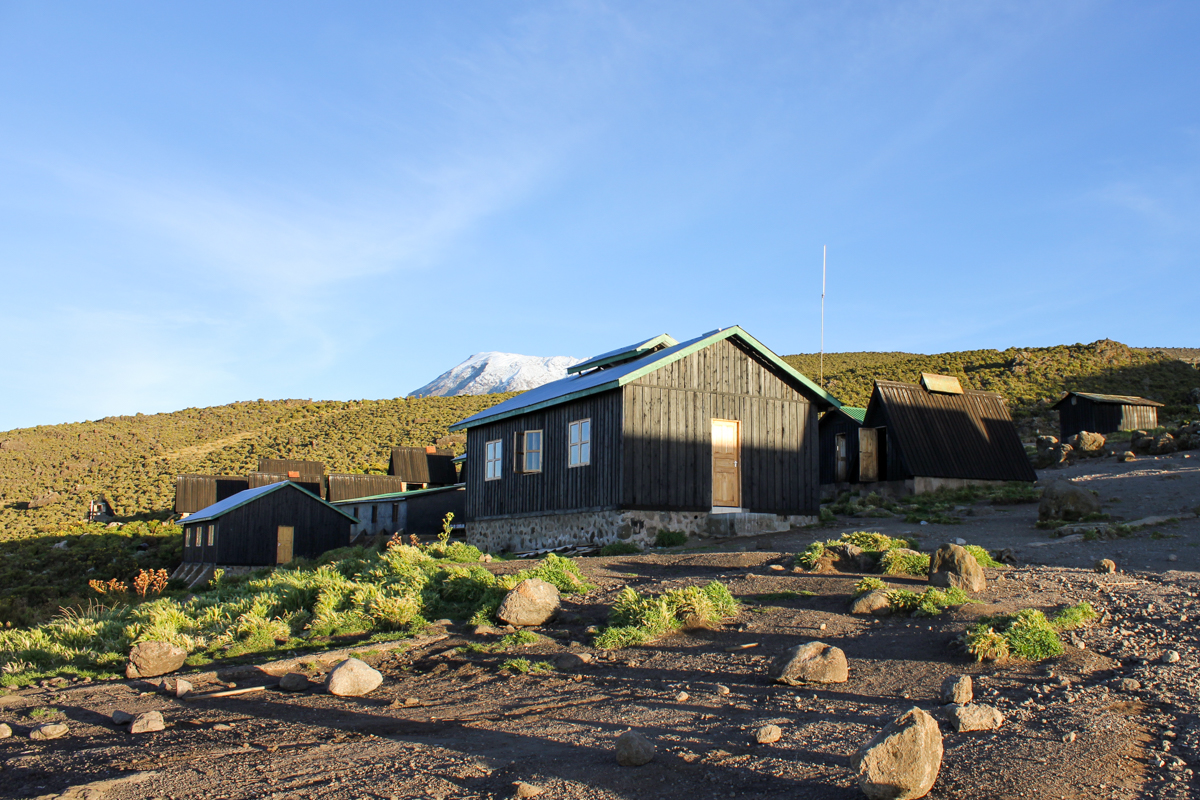
The exterior of Horombo Huts on the way back down (3720 m).
IF YOU GO
There are many travel agencies and expedition companies that offer guided climbs of Mt. Kilimanjaro. We elected to climb with locally based Zara Tours and had an incredible experience. Five-day, four-night climbs on the Marangu Route start at $1,555 USD.
We also climbed Mt. Rainier in Washington state with RMI Expeditions and were extremely impressed. RMI also offers Kilimanjaro climbs as part of a trek/safari combination. This is a 15-day itinerary and starts at $6,900 USD.
WHERE TO STAY
Zara Tours bases its Kilimanjaro trekking operations out of the Springlands Hotel in Moshi. We stayed at the hotel the night before and after our climb and it served as the perfect home base. The rooms are comfortably sized with en suite facilities. The property also has a quiet courtyard and outdoor pool.
Accommodation the night before and after your climb will likely be included in the price of your trek.